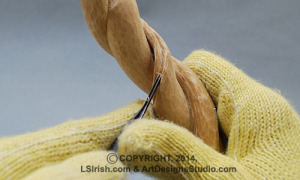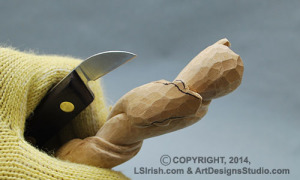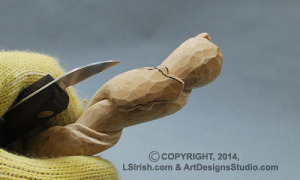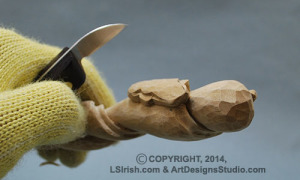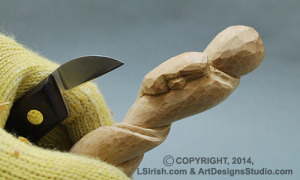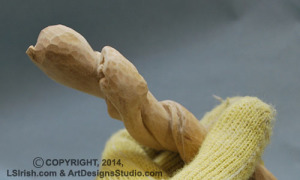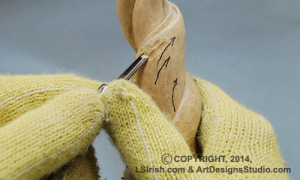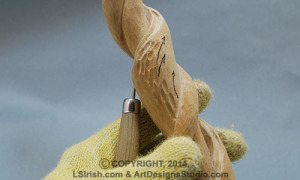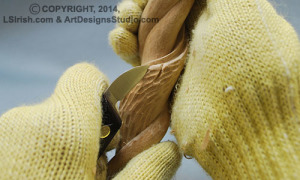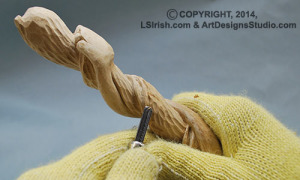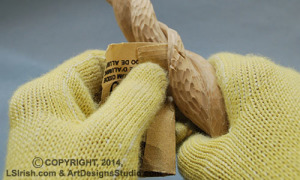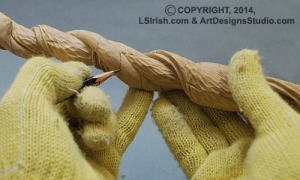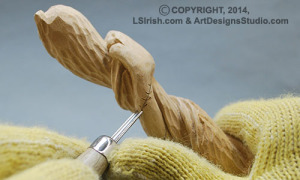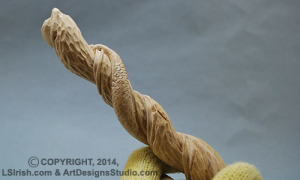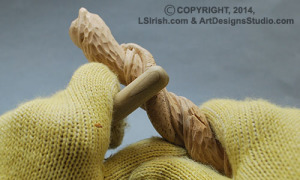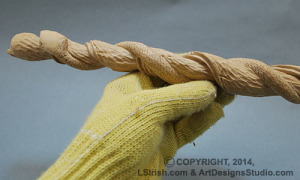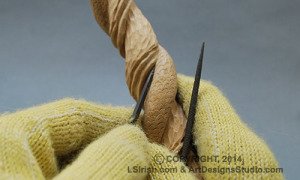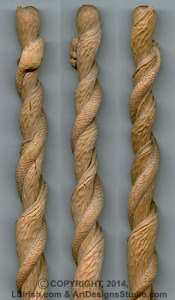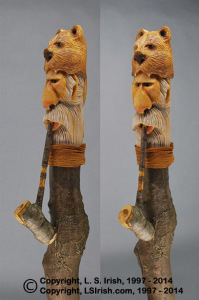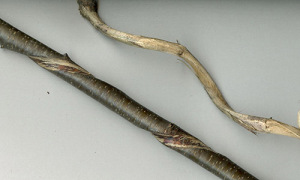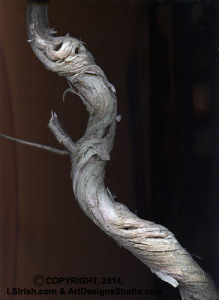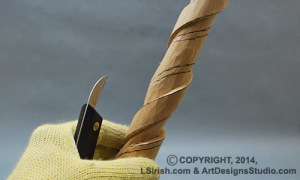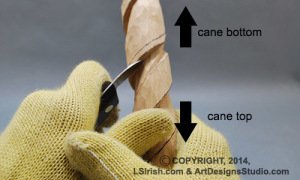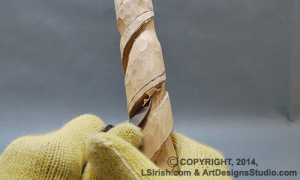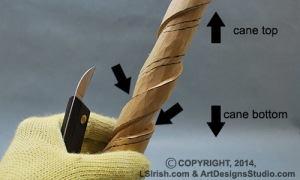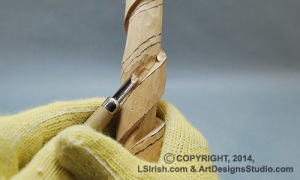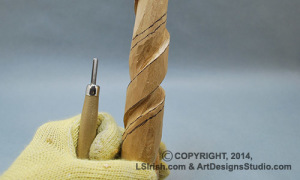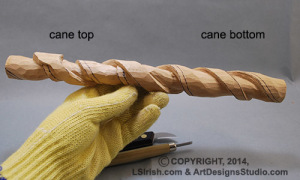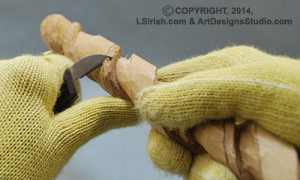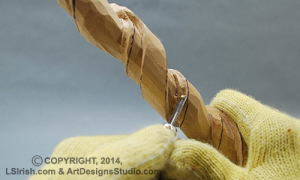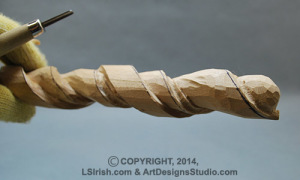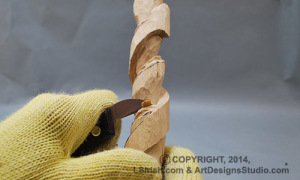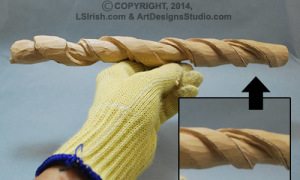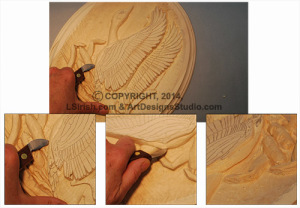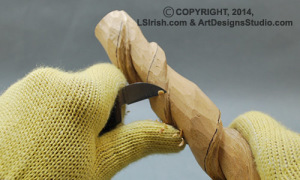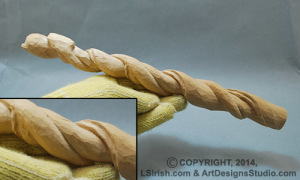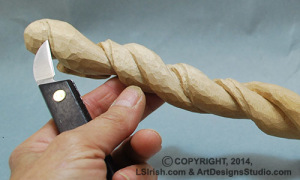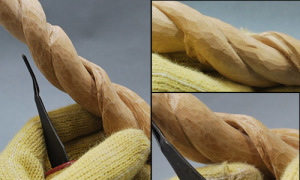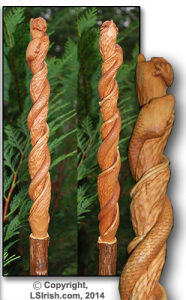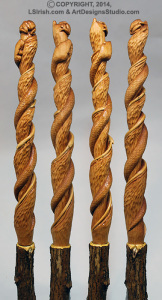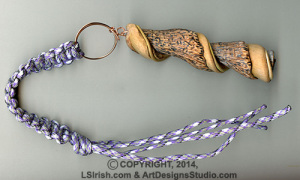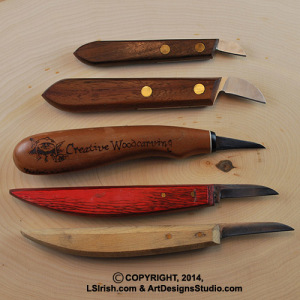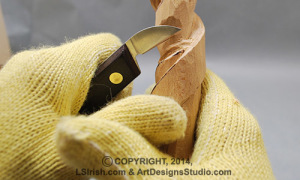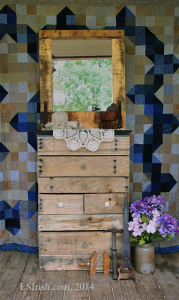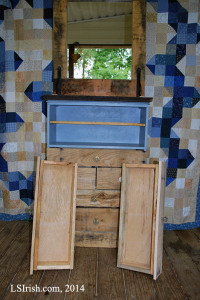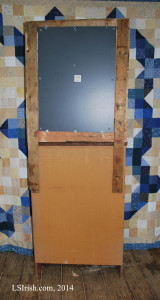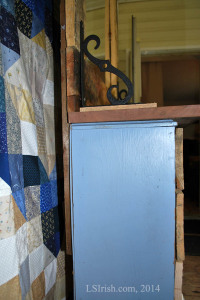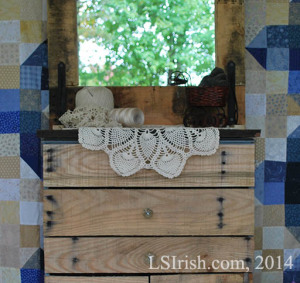Twistie Stick Snake Cane Carving, Day 4
Today we will deepen the honeysuckle twine area, shape and detail the snake’s head, add texture to the Sassafras bark, and do a general clean-up of the cane work. So, let’s begin having more fun!
Day 1 Twistie Stick Snake Cane Carving
Day 2 Twistie Stick Snake Cane Carving
Day 3 Twistie Stick Snake Cane Carving
Day 4 Twistie Stick Snake Cane Carving
Day 5 Twistie Stick Snake Cane Carving
Walking Stick Joinery
Walking Stick Wood Species – Harvesting Your Sticks
Walking Stick – Adding Extras
Walking Stick – How to Clamp Your Handle
Free Mountain Man Cane Carving Pattern
Step 13: Very small, tight-arced round gouges are called veining tools. This tiny round gouge makes straight-walled, round bottomed troughs, which are perfect for deepening our honeysuckle stem area.
Similar to the veining tool is the checkering tool used in gun stock carving. The checking tool comes with either a small round gouge or v-gouge, plus it has an adjustable l-shaped arm. You make your first cut line in your checkering pattern. Then adjust the l-shaped arm to the distance you want between the rows. Drop the arm into the first cut row, and it controls the distance between the rows as you cut the next.
I note the checkering tool here because while you may not ever try gun stock carving, those checkering tools make wonderful backgrounds for your relief work.
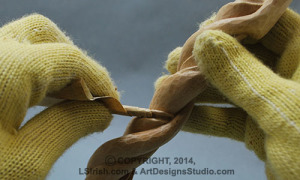
Tear a small square of 220-grit sandpaper from the large sheet and roll it tightly into a tube. Use the tube to sand the honeysuckle trough area along the top of each Sassafras twist.
Step 14: It’s time to shape the snake’s head. To begin this area, I re-marked the outline and eye placement of the snake with permanent marking pen. Since we will carve this area, any pen markers will quickly be worked away.
Cut along the outer edges to reduce any excess wood from the head.
Cut along the edge of the eye area with a stop cut to lower the eye slightly on the head.
Step 15: Round over the eye area, using the bench knife.
Make a small, slice in the head at the outer corners of the eye, to emphasize the eye, and to create the impress of the jaw and cheek.
A Quick Reminder – I am posting this Twistie Stick Snake Cane each day on my favorite carving forums. Stop by, join up, so that you can post your questions and photos!!!! Carving forums are like potato chips … just one is never enough … Grin!
FamilyWoodworking.org at Twistie Stick Snake Cane Thread
WoodworkingChat.com at Twistie Stick Snake Cane Thread
And while you wait to get started, visit Roy’s relief Carving Class thread – See our widgets in the right hand nav bar and on both forums!!!!
Step 16: Texturing the Sassafras bark is done with both the veining tool and your small round gouge. Cut small, shallow tear-shaped gouge strokes in the bark area using the small round gouge first.
Note in the photo that I am making the bark twist by angling my strokes with the curve of that twist area. Do a few veining tools cuts to add smaller texture strokes.
With the bench knife, make a few stop cuts along the top edge of the bark in the twist areas. These stop cuts make the bark appear cracked or split – a natural occurrence for any Sassafras stick.
Step 17: Bark, literally, lies on top of the wood of a stick. To emphasize that the bark and the wood are two different areas or elements, use your v-gouge to cut a small, thin trough where these two areas meet. You can also use your bench knife to make a few, shallow undercuts into the bark to make it appears as if the bark is slightly peeling.
A little more sanding … These cleaning steps are technically called ‘dressing out’ the wood and used to catch those little imperfections while you have them in your sights.
Step 18: There are many, many ways to work the scaling of the body of a snake, lizard, or dragon. What I am using here is the most simple and fool-proof that I know. In working my snake, I lost just two scales – two that ‘popped’ out during the cut and my solution to those two was to simply ignore them. Mistakes happen and sometimes trying to fix a mistake just makes them worse.
Begin by marking parallel lines along the snake body lightly with pencil. Also take a moment a re-fresh the edge of your small round gouge on your honing board or leather strop.
Up-end your round gouge, which means to hold the gouge at a 90 degree angle to the wood so that the cutting edge is go straight into the wood. Gently push the gouge into the wood to cut a half-circle profile cut. Lift the gouge straight out of the wood. This is a simple push and lift stroke.
I worked several up-ended small round gouge profile cuts along the guidelines to set the spacing of the rows. Then I worked off of that center cut to create the other profile cuts in the row.
Some of the profile cuts made with my small round gouge were slightly lifted from the snake’s body. To ‘heal’ them I rubbed the wooden handle of my gouge over the snake, moving from the head towards the tail. This light pressure sets the scales back against the wood.
Healing can be done at anytime in a carving. Example, if you make a stop cut that is slightly too deep, after the second stroke is complete, turn your bench knife upside down and place the blunt side against the deep cut. Use a medium pressure and pull the blunt side down the cut to ‘heal’ it back together. Work carefully! Remember, in this example, that cutting edge is now facing towards your hand!
This style of scale creation will leave a very light, gentle impression of scales along the body. They become more outstanding when you add the linseed oil finish later.
Step 19: At this point the work on the snake is complete, and the Sassafras carving is complete, except for adding the honeysuckle vine into the trough. This is a great stopping point for the weekend.
So, using your roll of sandpaper, rifflers (small, profiled files), and your bench knife take a little more time to dress out your cane. Next Monday we will begin work on carving the frog that holds onto the top of the stick, creating the joints for the cane and stick, and on the finishing oil steps.
But right now … you are ready to go make a bunch of twistie stick key chains for your family and friends as Holiday presents!!!! And, if you have questions, comments, or want to share your twistie stick carving, now’s the time.
